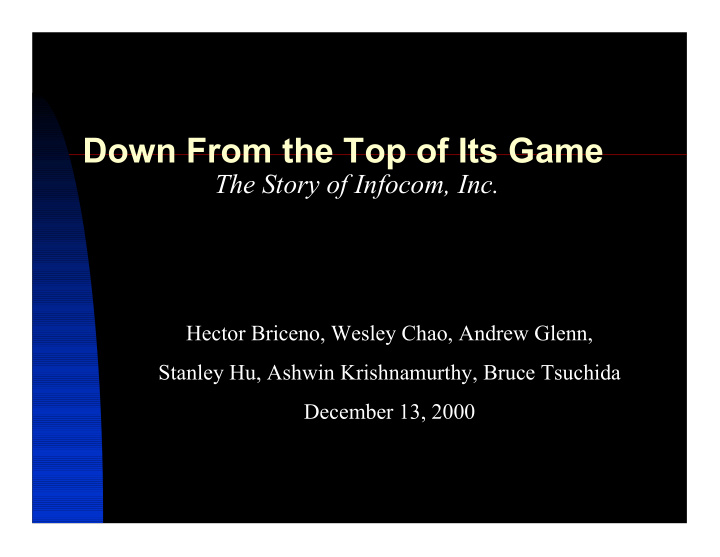



Down From the Top of Its Game The Story of Infocom, Inc. Hector Briceno, Wesley Chao, Andrew Glenn, Stanley Hu, Ashwin Krishnamurthy, Bruce Tsuchida December 13, 2000
Outline of Presentation � Founding and Background � Technical Achievements � Selling Games � Financial Success � Transition to Business Products � Problems in Transition � Conclusions
Founding and Background � Dynamic Modeling group at LCS � Created Zork for mainframes � Original intentions � Keep people together � Make serious software for PCs � Launched Zork to get started
Infocom’s Board of Directors From left: Marc Blank, Joel Berez (President), Al Vezza, J.C.R. Licklider, Chris Reeve
“…a level of 28 mg of Company Culture Budweiser Beer was also noted. This is equivalent to a goldfish drinking � Fun, humorous group eighteen six-packs in a � Young and funky seven minute period.”
Technical Achievements � Better English parser � The Z-machine � Made games compact � System of development � MDL � Platform-independent byte-codes � Efficient and cost-effective
Selling Games � Released Zork in 1980 for TRS-80 Model I � Spawned sequels, Deadline , Starcross , more
Why were games fun? � “Understood” many English sentences � Vivid stories, characters � Demographics
Self-publishing
Marketing and PR Discover , March 1984
Ads
TV
TV TV
Infocom Rockets to the Top Infocom's Sales (1981-1984) 12,000,000 10,000,000 8,000,000 Dollars 6,000,000 4,000,000 2,000,000 December 1983 0 1981 1982 1983 1984 Year
Shift to Business Products � Original intentions � Status � Diversify products � Monetary advantages � Higher profit margins � Consistent revenue stream “We didn’t want to be a $10 million company. We wanted to be a $100 million company.” -Tim Anderson
Cornerstone is Born � Cornerstone : relational database � Idea of two members from LCS � Work starts in 1982 Brian Berkowitz
Transition to Business Software � Changes in management � New CEO: Al Vezza � 32 to 100 employees in 1984 � New, expensive office building � Sought outside funding Al Vezza
Trajectory of Growth Infocom Game Sales (1983-1985) 16,000,000 12,000,000 Dollars 8,000,000 4,000,000 0 1983 1984 1985 Year Actual Projected
Trouble Arises � Costs up, revenues flat � Sales projections off � Inadequate funding � Clashes within company � Game profits business division � Games vs. business work styles � Morale sank
Cornerstone Released in 1985 � Easy to use � Not programmable, slow � $1.8 million in sales
Struggling to Make it � Debts � Lost over $4 million in 1985 � Bank called in loan � Cut costs � Layoffs � Cornerstone axed
Activision Merger (1986) Jim Levy (left) and Joel Berez (right) celebrating “InfoWedding” for Activision merger
Continuing Problems � Losses of $200,000/quarter � Increased competition: Nintendo, Sega, graphics � Infocom dismantled in 1989 Rise of Nintendo, graphics
Reasons for Success � Games: right products at the right time � Demographics matched products � Graphics in infancy Mystery House, 1980 Ultima II, 1982
Reasons for Success � Company culture excelled at making games � Good marketing and public relations
Text vs. graphics
Reasons for Failure � Engineering culture resisted graphics � Cornerstone : wrong product, wrong time � Performance and functionality � dBASE III � Lack of finances � Spent money didn’t have
What Can We Learn? � Business Lessons � No universal strategy for success � Buy time to improve and refine new products � Success and failure not simple!
Thanks to… Tim Anderson, Joel Berez, Brian Berkowitz, Marc Blank, John Brackett, Scott Cutler, Bruce Daniels, Mike Dornbrook, Stu Galley, Dan Horn, Richard Ilson, Barry Jacobson, David Lebling, Steve Meretzky, Mike Morton, Chris Reeve, Al Vezza, Richard Weissberg
Game Over
Recommend
More recommend